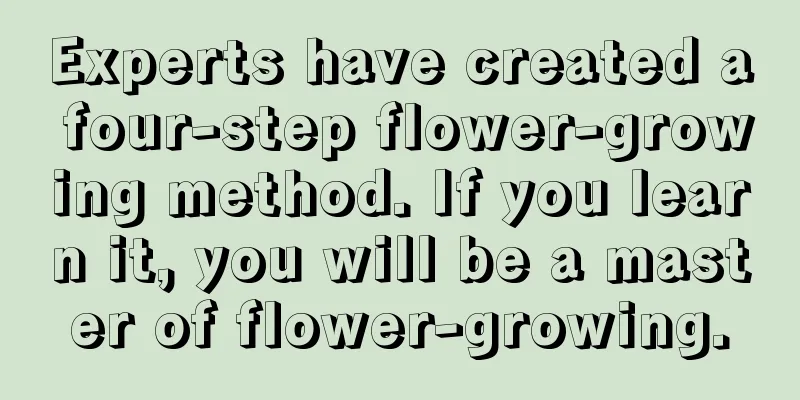Experts have created a four-step flower-growing method. If you learn it, you will be a master of flower-growing.

Step 1: Choose a substrate that is both water-retaining and breathableThis is the most important prerequisite for growing flowers well. If you can achieve this step, you will be 50% successful in growing flowers. The leaf mold on the mountain, special substrate for growing flowers, and sphagnum moss are all very good substrates for growing flowers. Don’t try every possible means to find soil for growing flowers. Not only is it a waste of time, but it is also difficult to find good soil. The key is that it is difficult to grow good flowers with such soil. Buy some "water-retaining and breathable medium" to grow flowers, we have money! ! ! Step 2: Combine qualitative and quantitative wateringDon’t ever believe in the “watering method of how often” again. Not only will you not be able to grow flowers well, it will also often make you a “plant killer”. 80% of people have trouble growing flowers because of watering problems. Why? Water evaporation is the main reason why flowers need watering. Every family’s environmental conditions may be different. For example, in the same community and at the same time, some families turn on the air conditioner while others do not. The evaporation of water is completely different. If we judge whether to water the flowers according to the "time quantification standard", problems are often unavoidable. Whether watering is needed should be "qualitatively judged" rather than judged according to "time quantitative standards". The so-called "qualitative judgment" means that you can judge whether watering is needed by observing the color changes of the flower planting substrate or the touch or wetness of the substrate with your hand. Commercial nutrient soil or sphagnum moss will turn white when lacking water. If you touch your hand and there is no sign of moisture, you should water it. The so-called "quantitative watering" is to determine the appropriate amount according to the size of the flower pot, and then water it quantitatively each time. When growing flowers in a matrix, the relative water content of the matrix is about 60%, and its moisture and air content is most suitable for plant roots. There is a simple method to judge, which can be used when planting: grab a handful of substrate and hold it tightly, and water should drip down from between your fingers instead of flowing down. Step 3: Use the right fertilizerFlowers and plants not only need to "drink water", but also "eat". Fertilizer is the "food" of plants. If she is not allowed to eat for a long time, she will become pale and thin due to hunger. Just like us humans, we cannot be picky eaters when it comes to food. Eating too much will cause diarrhea (excessive fertilizer will burn the seedlings). Flowers also need a balanced diet. The best and easiest way for beginners to grow flowers is to apply "slow-release granular fertilizer". Such as "Aolvfei, Shileke" and so on. This fertilizer has balanced nutrients and uses "coating technology" to slowly release the fertilizer effect. Even if you apply a little too much, it will not burn the seedlings, at most it will be a little waste. Experienced flower growers can use complete soluble fertilizers, combined with watering the roots, or spraying them on the leaves. If you can do this step well, you are 90% successful. The fourth step is to put it in the right placeIn other words, where should you place the flowers in your home so that they can grow well? The very least you need to know is whether the flowers you grow are shade-tolerant or light-loving, and then place them according to the lighting conditions in your home. Secondly, even shade-tolerant flowers and plants need to be placed in a bright place to bask in the sun after a period of time. Placing flowers in the right place also includes their temperature requirements. Experts tell you a simple method: In fact, the suitable environmental temperature for all organisms is similar. If you feel too hot or too cold, try to place your flowers in a place in your home where you will feel more comfortable, but be sure to avoid sudden changes in temperature in a short period of time. If you can do this step well, you are 95% of the way there. You can be called an expert in growing flowers. |
<<: How to make roses bloom more beautifully and fragrantly
Recommend
How to make Christmas cactus bloom continuously and how to care for it after it blooms
1. How to make Christmas cactus bloom continuousl...
The role and efficacy of peaches
1. Diuretic Peaches contain phenol, which can act...
How to propagate the heartleaf vine
Cutting propagation of spatholobifolia The best t...
What to do if the gardenia buds turn yellow
1. Water appropriately 1. Reason: Although garden...
There are hidden rules for buying flowers at the flower market, and the boss will never tell anyone about it. I'm shocked!
Be careful with foam pelvic floor pads Flower lov...
Can Mimosa be pruned? How to prune branches and leaves?
Can Mimosa be pruned? Mimosa can be pruned, but y...
How to grow Jinhuangxing succulent
Jinhuangxing Succulent Growth Conditions The succ...
Where is the best place to grow chives? What are the best environmental conditions for growth?
Leek planting area Chives are suitable for planti...
The nutritional value of tomatoes. Is it better to eat tomatoes raw or cooked?
1. Nutritional value of tomatoes Tomatoes are ric...
Common diseases and pests of Bougainvillea and their control methods
Bougainvillea leaf spot symptom The spots are ini...
What kind of vegetables are suitable for growing in glass greenhouses (What kind of vegetables are suitable for growing in greenhouses)
Glass greenhouse vegetable planting The glass gre...
Can pregnant women eat durian? How to choose durian?
1. Can pregnant women eat durian? Pregnant women ...
You can grow any flower in summer, but this kind of flower, 10 pots are not too much
Mint Care Light: Mint particularly likes sunlight...
How to plant peony seedlings? How much does a peony seedling cost?
1. Planting method 1. Time: The best time to plan...
What to do if there are large white spots on the leaves of the fortune tree
1. Proper ventilation Cause: Poor ventilation lea...









